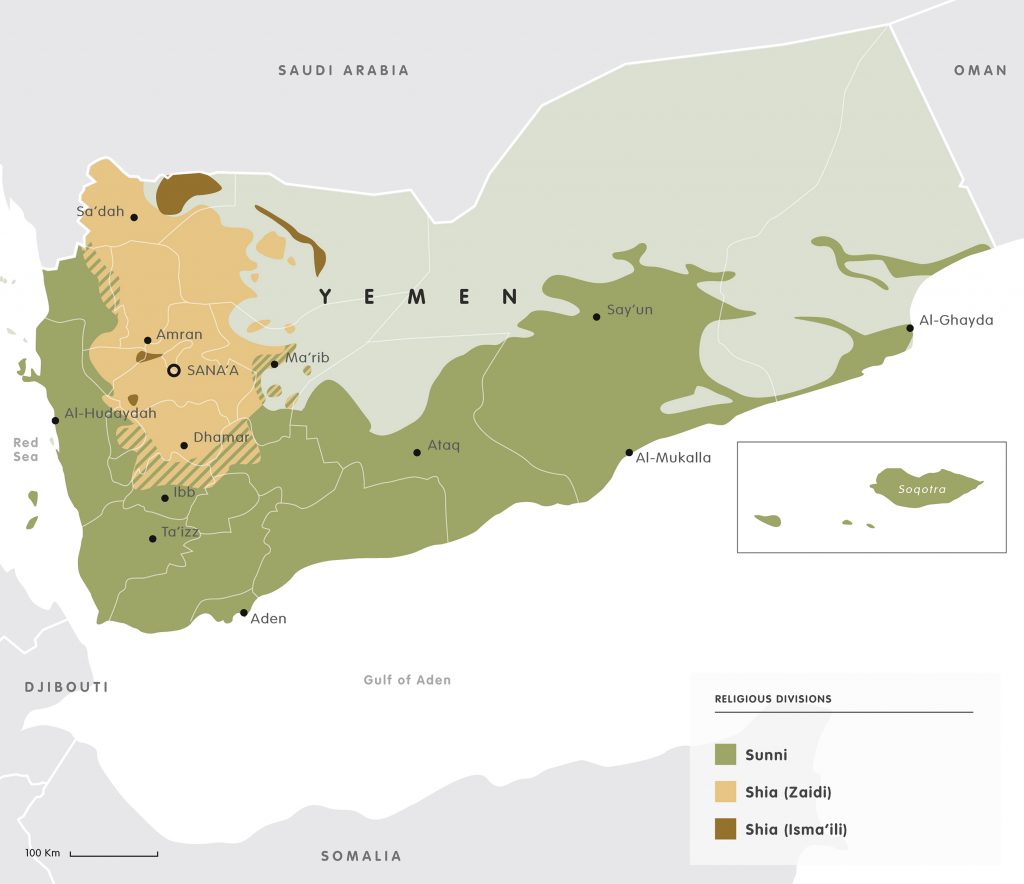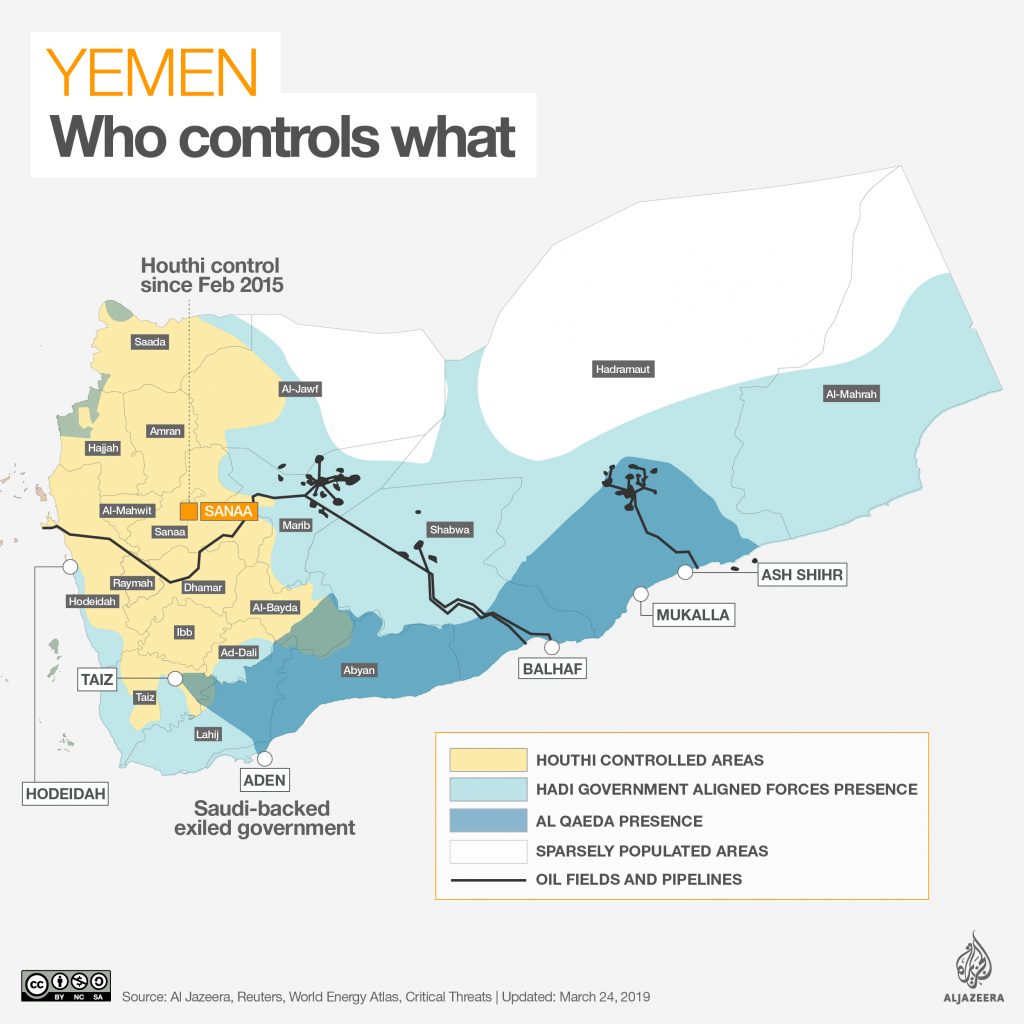August was a disastrous month for Saudi Arabia’s coalition in Yemen. On August 10th, militias of the Southern Transitional Council (STC), a Yemeni secessionist group, captured the port city of Aden from Saudi-backed government forces. Just one day later, a delegation of Houthi leaders arrived in Tehran to discuss future diplomatic engagement with the Iranian regime, Saudi Arabia’s historic rival. Internal fighting has led to even more chaos; at the end of August, the Yemeni government alleged that Emirati airstrikes had killed 25 of its soldiers attempting to retake Aden from the STC. Hundreds more were wounded, igniting a diplomatic feud between the Yemeni and Emirati governments.
These are concerning developments in Yemen’s civil war. As the conflict enters its fifth year, old alliances have deteriorated and new partnerships have coalesced. Fractures within the Saudi alliance, coupled with deepening ties between the Houthi movement and the Iranian government, will likely undermine progress towards peace in Yemen and intensify fighting between groups for the coming months.
Competing regional and international actors have transformed Yemen’s conflict into a bloody stalemate, yet the origins of the war are best understood through the lens of domestic unrest. In 2004, members of the Houthi family established an anti-government movement to achieve political autonomy and counter the spread of Sunni ideologies. The group engaged in multiple clashes with Yemen’s security forces, establishing itself as a protector of marginalized northern communities. The government’s indiscriminate use of force encouraged sympathy for the Houthis and strengthened the group’s tribal networks. These relationships would develop into crucial assets for the Houthi movement.

Source: European Council on Foreign Relations
During the Arab Spring in 2011, the Houthis harnessed popular discontent among the northern tribes to mount an insurgency against Yemeni President Ali Abdullah Saleh, seizing Saada province. Meanwhile, thousands of protesters mobilized throughout the country to denounce corruption and demand new political leadership. Bowing to pressure, President Saleh stepped aside for former Vice President Abdu Rabbu Mansour Hadi to assume leadership, fostering a sense of optimism. Yet reforms stalled and the Houthis seized the initiative. The group captured the capital of Sana’a in 2014, calling for the reinstatement of fuel subsidies and the dissolution of the nascent government.
In response to these demands, President Hadi’s administration drafted a new constitution that divided Yemen into six federal states. The last-ditch effort did not satisfy the rebels. The Houthis rejected the power-sharing arrangement, dissolved the national parliament, and placed President Hadi under house arrest. In March 2015, the movement’s fighters led a southern offensive, overtaking the city of Aden. Saudi Arabia, fearing a spillover of the conflict along its southern border, appealed to the Gulf Coalition Council (GCC) to reinstate President Hadi. The coalition submitted to Saudi Arabia’s wishes and approved a series of airstrikes against Houthi targets. Aden was reclaimed within a week.
The kingdom’s quick victory convinced Saudi leadership that the intervention would be short-lived. This judgement was a costly miscalculation. The Houthi insurgency proved remarkably resilient, outlasting Saudi aerial strikes, naval blockades, and ground offensives. The coalition is now under even greater stress from within; recent disputes between Saudi Arabia and its coalition partner, the United Arab Emirates (UAE), have made the task of dislodging the Houthis exponentially more difficult.
Competing Saudi and Emirati strategies in Yemen have eroded the two countries’ partnership. At the outbreak of the conflict, the UAE and Saudi Arabia were close partners; Saudi Arabia directed airstrikes while UAE troops launched ground assaults in Yemen’s southern provinces. As the humanitarian and political costs of the conflict grew, however, the UAE pursued its own objectives, infuriating Saudi Arabia’s leadership in the process. While the UAE is hesitant to support a prolonged conflict, Saudi Arabia is determined to sustain military pressure against the Houthis to protect its position as the dominant regional power in the Gulf.
The UAE’s preference for mediation in past months has undercut ongoing coalition operations. The Emirati government has expressed recent interest in peace talks with the Houthi rebels, a complete departure from Saudi Arabia’s strategy of unrelenting military pressure. The UAE’s rollback from the port city of Hodeida underscores the country’s apprehension towards a protracted mission in Yemen. Top Emirati officials note a strong desire to “end the war in 2019,” assessing that dialogue with Houthi rebels can prevent further bloodshed while building the UAE’s connections with Yemen’s plethora of armed groups. The UAE’s diplomatic efforts might pause the fighting temporarily, but Saudi Arabia will likely rebuff any negotiation efforts. Yemen’s war will thus worsen as the coalition’s members pursue diverging agendas.
The UAE’s operational decisions have also fomented violence amongst factions in Yemen. In July, the UAE withdrew most of its forces from the country, a crushing blow to Saudi Arabia’s campaign against the Houthis. The rapid withdrawal of Emirati troops has left a power vacuum that secessionist groups are eager to fill. STC militants, funded by the UAE, have launched a series of deadly attacks on government forces loyal to President Hadi, Saudi Arabia’s closest ally in Yemen. Internecine fighting between Emirati and Saudi-backed proxies marks a new low point in Saudi Arabia’s effort to resolve the conflict in Yemen.

Source: Al Jazeera
The recent outbreak of violence between coalition groups has also offered wider freedom of movement to terrorist groups such as al Qaeda in the Arabian Peninsula (AQAP) and the Islamic State’s Yemen affiliate (ISIL-YP). These groups have suffered serious defeats to U.S. military operations, losing territory from sustained airstrikes and ground raids by coalition forces. Coalition infighting within the last several weeks, however, draws attention away from AQAP and ISIL-YP and provides an opportunity for planning future attacks.
The UAE’s reversals on diplomatic mediation and troop deployments have triggered a cascade of violence. Cooperation is exceptionally rare within Yemen’s muddled war, yet the parties that can put aside their differences for common strategic objectives can enjoy substantial benefits. The rift between Saudi Arabia and the UAE, however, signals the coalition’s inability to contain Yemen’s overlapping conflicts.
The widening divide between Saudi Arabia and the UAE has primarily benefited Houthi insurgents. The Houthis have struggled to maintain territory as local militias, government forces, and UAE troops along the Red Sea coastline push the insurgents into the northern highlands. Yet the Houthis are leveraging the rising tension within the Saudi-led campaign to sow animosity among coalition members. On August 1st, Houthi rebels launched a ballistic missile to strike a STC military parade in Aden, killing 36 soldiers. STC officials were quick to accuse President Hadi’s government forces of conspiring with the Houthis in the attack. Fighting erupted throughout the city, once again exposing the coalition’s inability to manage their beneficiaries’ actions.
A divided alliance also rewards Saudi Arabia’s greatest adversary: the Islamic Republic of Iran. Iran’s hopes of establishing a foothold in the Gulf region were realized when fighting broke out between the Houthis and the Saudi-backed Yemeni government in 2011. Iranian shipments of advanced military technology for Houthi fighters have steadily bolstered Houthi capabilities. Seizures of Iranian ballistic missiles, explosives, and unmanned aerial vehicles (UAVs) by coalition forces confirm Iran’s growing role in Yemen’s conflict. Explosive debris inspected by U.N. experts in 2018 also suggest a “high probability” that ballistic missiles used in Houthi attacks were manufactured in Iran. Iranian arms in Yemen is a worrisome development that will lengthen the conflict’s duration.
Meanwhile, senior Iranian officials have pledged other forms of assistance for the Houthi movement. Iran’s Supreme Leader Ayatollah Khamenei, after convening a meeting with Houthi leadership in Tehran, voiced his support for the resistance against “Saudi-led plots to divide Yemen,” highlighting the country’s growing regional rivalry with Saudi Arabia. Tehran has diversified its aid packages for the Houthis to include armaments, fuel, and trainers. These resources accomplish three goals for Tehran: sustaining the Houthi movement, threatening the security of Saudi Arabia’s borders, and securing Iranian influence in the Gulf region. The Iranian-Houthi partnership also weakens the legitimacy of President Hadi, whose security forces must now face Iranian-backed proxies capable of deploying advanced military hardware.
Iran has also facilitated the flow of military advisers to train Houthi fighters. Lebanese Hezbollah, Iran’s most powerful proxy group, has provided training assistance and support for Houthi forces in Yemen. Hezbollah operatives are likely responsible for introducing the Houthis to advanced weaponry from Iran, including long-range ballistic missiles and UAVs. Iran’s proxies have added deadlier capabilities to the Houthi arsenal, all but ensuring a bloody stalemate.
Iran’s decision to expand its financial, diplomatic, and military networks in Yemen is an effective strategy. The country has entrapped Saudi Arabia in an expensive military campaign; estimates suggest that the war has drained over $100 billion from the Saudi kingdom’s treasury, while Iran has spent a few million dollars. The Houthis, now equipped with Iranian missiles and training, can launch fresh missile attacks into Saudi Arabia while Tehran exerts significant influence over future developments in Yemen and the wider Gulf Region. The alarming drone strikes on Saudi oil facilities in September highlight Iran’s growing confidence against its enemies. The exchange of Iranian weapons, trainers, and funding diminishes hope of peaceful resolution for Yemen and escalates the chance of conflict between Riyadh and Tehran.Ruptures within the Saudi-led coalition and the emergence of new actors in Yemen are worrisome signs for the country’s future. Total casualties exceed 91,600 since the start of the conflict, and roughly 80 percent of the population depends upon foreign assistance to survive. Security will deteriorate as Saudi and Emirati policies draw apart and Iran fills the gap left behind. The reunification of Yemen will be a delicate process; a successful resolution of the conflict must reconcile a long list of grievances between the central government and competing factions. The common mantra of decentralizing political power has a poor track record in Yemen that will accomplish little in the ongoing crisis. Instead, new political incentives and material benefits must be considered to pacify armed groups and encourage regional powers’ exit from the conflict.